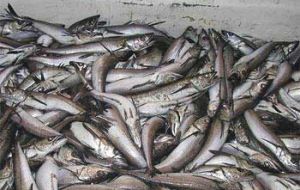MercoPress. South Atlantic News Agency
Outlook for hake in South Atlantic remains “worrisome”
 Successfully recovering the breeding hake biomass is key for a stable stocks replacement rate. (Photo: FIS)
Successfully recovering the breeding hake biomass is key for a stable stocks replacement rate. (Photo: FIS) The situation of common hake (Merluccius hubbsi) is extremely worrying in the South Atlantic as “low recruitment levels in the last three years are having an effect on the brood stock biomass” according to Argentina's Institute for Fisheries Research and Development (INIDEP) Research Director Otto Wohler.
During an open meeting organised by the Argentine Wildlife Foundation to celebrate World Ocean Day, Wohler stated that although the species has proven itself capable of recovering with time in the past, today it is showing signs of weakness. "The estimated recruitment of [the southern stock] for 2008 was average between 2006 and 2007. This means that the declining trend of the the last two years has reverted but recruitment is still considered low. This drop is not as dramatic as the one that took place during the 1999-2000 period. However, it remains a matter we must worry about," stated the INIDEP official. "The decline could be a combined effect of direct fishing and adverse environmental factors" said Wohler, a possibility INIDEP is currently looking at this moment, he added. "We are very close [to concluding] that recruitment has been affected by a lack of brood stock. The goal is to recover the reproductive biomass until it reaches a minimum of 400,000 tonnes. This will help stabilize recruitment levels," he declared, Pescarereports. The brood stock biomass was stable for a number of years at a minimum level of 400,000 tonnes, which later fell to a borderline level of 300,000 tonnes, "too low for fishing," the official said. Regarding the northern stock, Wohler stated: "There is also a declining tendency." Low recruitment levels were observed in 2005 and 2006, despite a noted increase in 2007. "Nevertheless, that has yet to be verified in the 2008 survey. Sometimes a single observation may lead to an error," he said. However "the tendencies of the total and reproductive biomass are definitely falling. The brood stock biomass fell below the 100,000-ton mark since 1999, and remained relatively stable, but at very low levels since then" Wohler was emphatic. "Since 1986 the northern stock has declined between 60 and 80% as a result of excessive fishing and diminishing recruitment levels that failed to successfully recover the brood stock biomass. In terms of the stock-recruit ratio, the hake population is currently over-fished in terms of recruitment levels. That is, stocks have been affected in such a way that these cannot generate a sufficient recruitment level for an effective recovery" underlined Wohler. Although fishing is banned in certain areas during the spring, summer, and autumn, to protect juveniles, a winter ban is also necessary, insisted the Argentine researcher. On this topic, INIDEP suggested that the Enforcement Authority complete statistics regarding the currently banned areas of half of the entire area. The goal is to strengthen conservation measures on juveniles, including one year-olds and those most recently spawned, based on the data collected during the January survey. According to INIDEP's Technical Report 18/08, the average hourly yield in total weight of juveniles and adults revealed a declining tendency throughout the period: 11% fall between 2007 and 2008; and 73% decline between 2005 and 2008. In terms of indexes per age group obtained according to size, an increase was observed in both groups involved. Between January first and 13 June, 124,290.2 tonnes of hake were landed, confirmed the Secretariat of Agriculture, Livestock, Fisheries, and Food (SAGP&A). However between Jan 2007 and June 25 last year, 140,731.8 tons of hake were landed. Of the total landed until 13 June, 32,603.1 tons were fished north of parallel 41º South while 91,687.1 tons were fished South of the same parallel. (FIS/MP).-




Top Comments
Disclaimer & comment rulesCommenting for this story is now closed.
If you have a Facebook account, become a fan and comment on our Facebook Page!